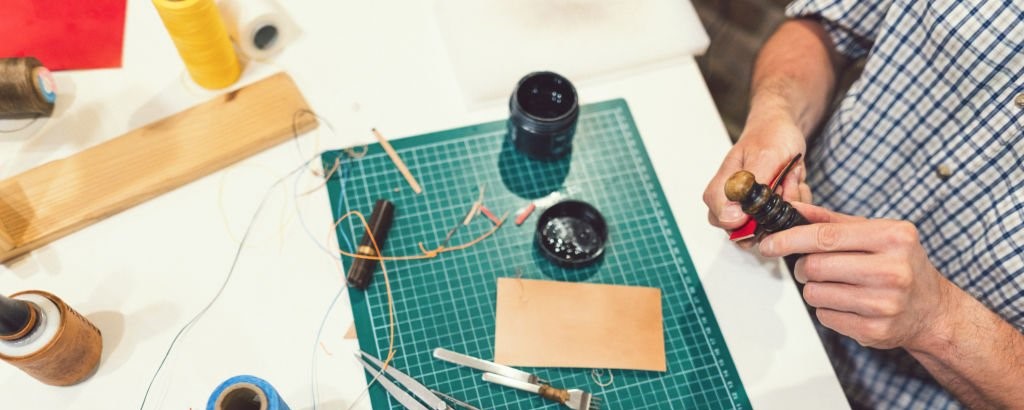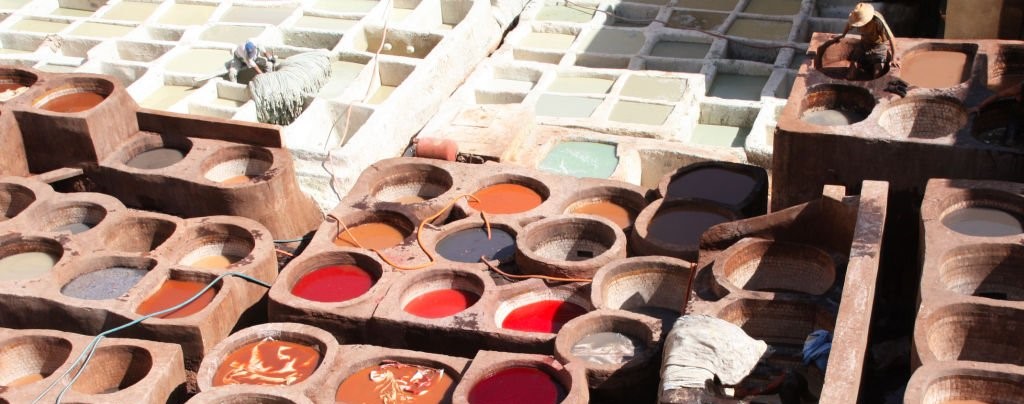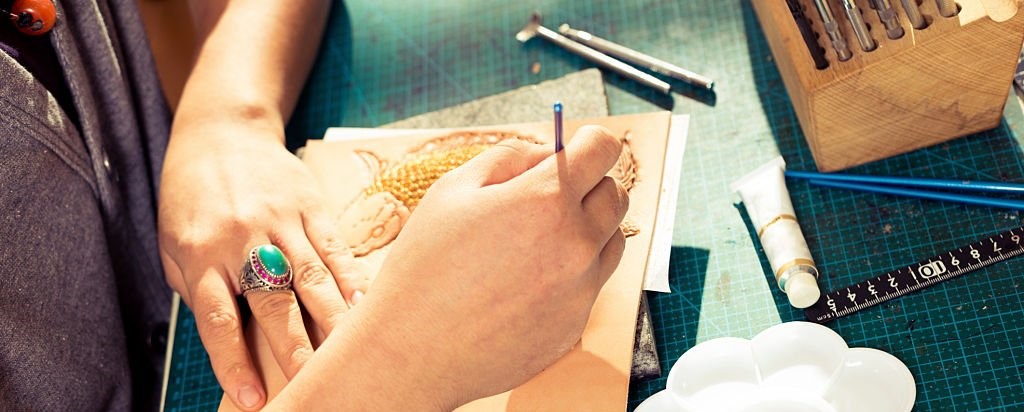Techniques for Leather Finishing

Leather finishing techniques are essential for enhancing the quality, durability, and aesthetic appeal of leather products. These techniques involve various processes, including tanning, dyeing, and final finishing. Below is a detailed explanation of these techniques:
1.Tanning :
Tanning is a key stage in the process of transforming raw hides into leather. This process involves the use of chemical or natural substances to stabilize and preserve the hide, preventing decay and imparting desirable characteristics to the leather. Below, the different types of tanning and details related to each are explained.
A. Vegetable Tanning :
– Method: This method uses natural tannins, typically extracted from the bark of trees, fruits, and other plant sources. These tannins penetrate the hide and enhance its durability.
– Time: The vegetable tanning process is usually time-consuming, taking several months. This duration is primarily due to the need for the tannins to fully permeate the hide’s structure.
– Characteristics:
– High Durability: Leather tanned using this method is known for its robust durability and resistance.
-Natural Color: Such leathers often exhibit warm, natural colors that change and develop character over time.
-Environmental Friendliness: Vegetable tanning is less harmful to the environment due to the use of natural materials.
B. Chrome Tanning :
-Method: This technique involves the use of chemical compounds, particularly chromium salts, for tanning the hide. This process can be completed in a much shorter time compared to vegetable tanning.
-Time: Chrome tanning typically takes only a few days to a week.
-Characteristics:
-Softness and Flexibility: Leather tanned using this method is generally softer and more flexible.
-Variety of Colors: These leathers can be easily dyed, allowing for a wide range of color options.
-Environmental Concerns: The use of chromium and other chemicals can raise environmental and health concerns.
C. Combination Tanning ;
-Method: This method combines elements of both vegetable and chrome tanning. Initially, the hide is tanned using natural materials and then finished with chemical tanning.
– Characteristics:
– Desirable Properties: Leather produced using this method typically exhibits the best qualities of both techniques, offering both high durability and softness.
– Versatility: This type of leather is suitable for a wide range of leather products, including bags, shoes, and garments.
2. Dyeing :
Dyeing is a crucial step in the leather finishing process, as it adds color and enhances the aesthetic appeal of leather products. This process can significantly impact the overall quality and marketability of leather goods. Below, we explore the various methods, materials, and considerations involved in leather dyeing.
A. Methods of Dyeing :
Water-Based Dyeing:
– Description: Water-based dyes are made from natural or synthetic pigments that are dissolved in water. This method is increasingly popular due to its lower environmental impact.
– Characteristics:
– Ease of Application: These dyes are easy to apply and can penetrate the leather well.
– Environmental Benefits: Water-based dyes are generally less toxic and more environmentally friendly compared to solvent-based dyes.
-Color Variability: They can produce a wide range of colors, though they may be less vibrant than some chemical dyes.
Chemical Dyeing:
– Description: This method uses synthetic dyes that are chemically formulated to bond with the leather fibers. It is often used for its vibrant colors and quick application.
– Characteristics:
– Vibrancy: Chemical dyes can achieve bright, bold colors that are often more intense than natural dyes.
– Durability: These dyes are typically more resistant to fading and wear, making them suitable for high-use products.
– Environmental Concerns: The use of synthetic chemicals can pose environmental and health risks, necessitating careful handling and disposal.
Aniline Dyeing:
– Description: Aniline dyes are transparent dyes that penetrate the leather, allowing the natural grain and texture to show through.
– Characteristics:
– Natural Appearance: This method enhances the leather’s natural beauty and maintains its texture.
– Sensitivity to Stains: Aniline-dyed leather can be more susceptible to staining and fading, requiring careful maintenance.
Pigmented Dyeing:
– Description: Pigmented dyes contain larger pigment particles that sit on the surface of the leather, providing a more opaque finish.
– Characteristics:
– Color Consistency: This method offers uniform color coverage and is less affected by the natural variations in the leather.
– Protection: Pigmented dyes can provide additional protection against wear and staining, making them suitable for items that require durability.
B. Dyeing Techniques :
Dip Dyeing:
– The leather is submerged in a dye solution, allowing for uniform color penetration. This method is effective for achieving deep, saturated colors.
Spray Dyeing:
– A spray application method that allows for controlled and precise coloring. This technique is useful for adding patterns or for leather goods with complex shapes.
Brushing and Rubbing:
– Dyes are applied using brushes or cloths, allowing for artistic effects and variations in color intensity. This method is often used for custom designs or finishes.
C. Considerations in Dyeing :
Leather Type:
– Different types of leather (e.g., full-grain, top-grain, suede) may react differently to dyes, affecting the choice of dye and method used.
Color Fastness:
– It’s important to ensure that the dye used is colorfast, meaning it won’t bleed or fade when exposed to water or light.
Environmental Impact:
– Manufacturers must consider the environmental implications of the dyes used, opting for sustainable and non-toxic options whenever possible.
Post-Dyeing Treatment:
– After dyeing, leather often undergoes additional treatments, such as conditioning and finishing, to enhance its appearance and durability.

3. Finishing :
Finishing is the final step in the leather production process that enhances the appearance, texture, and durability of the leather. This stage is crucial in determining the leather’s quality and suitability for various applications. Below, we explore the different types of finishing techniques, their purposes, and considerations involved in the finishing process.
A. Types of Finishing Techniques :
Protective Coatings:
– Description: These are applied to the leather surface to protect it from water, stains, scratches, and general wear and tear.
– Characteristics:
– Water Resistance: Protective coatings can make leather more resistant to moisture, which is essential for items like shoes and bags.
– Durability: They help extend the lifespan of leather by providing a barrier against environmental elements.
– Types of Coatings:
– Acrylic Coatings: Provide a clear, protective layer that enhances durability without altering the leather’s natural look.
– Polyurethane Coatings: Offer a strong, flexible finish that can be more resistant to scratches and scuffs.
Gloss Finishing:
– Description: This technique uses gloss-enhancing materials to give leather a shiny and polished appearance.
– Characteristics:
– Visual Appeal: Glossy finishes are popular for luxury items, as they enhance the leather’s aesthetic appeal.
– Surface Protection: Gloss finishes can provide an additional layer of protection against stains and dirt.
– Application Methods: Often applied through spraying or rolling to achieve an even finish.
Matte Finishing:
– Description: This method results in a non-reflective, natural look for the leather.
– Characteristics:
– Natural Appearance: Matte finishes allow the leather’s natural texture and grain to be visible, appealing to consumers seeking authenticity.
– Feel: This type of finish often has a soft, tactile feel, suitable for casual and everyday products.
– Maintenance: While it may show dirt less than glossy finishes, matte leather can be more susceptible to staining.
Antique Finishing:
– Description: This technique gives the leather a vintage look, often by applying darker dyes or finishes to highlight the natural grain.
– Characteristics:
– Character: Antique finishes can enhance the leather’s texture, adding depth and an aged appearance.
– Application: Typically involves multiple layers of dye and finish to achieve the desired effect.
Texturing:
– Description: Creating specific patterns or textures on the leather surface to add visual interest.
– Characteristics:
– Methods: Can be achieved through embossing, debossing, or using specialized tools to imprint designs onto the leather.
– Customization: Textured leather is often used for unique, high-end products, allowing for personalization.
B. Considerations in Finishing :
Leather Type:
– Different types of leather (e.g., full-grain, top-grain, suede) may require different finishing techniques to achieve optimal results.
Intended Use:
– The intended application of the leather (e.g., upholstery, fashion, accessories) will influence the choice of finishing techniques. For example, leather for furniture may require more robust protective finishes compared to that used for garments.
Environmental Impact:
– Manufacturers should consider the environmental implications of the finishing materials used. Sustainable options and non-toxic chemicals can help minimize negative impacts on the environment.
Quality Control:
– Ensuring consistent application of finishes is critical to maintaining product quality. This includes monitoring the thickness of coatings, uniformity of color, and overall appearance.
4.Special Techniques :
Special techniques in leather treatment enhance the uniqueness, functionality, and overall quality of leather products. These techniques go beyond traditional tanning, dyeing, and finishing processes, allowing manufacturers to create distinctive and high-value items. Below are some notable special techniques used in the leather industry:
A. Texturing :
Description:
– Texturing involves creating specific patterns or surface finishes on leather. This technique adds visual interest and depth, making the leather more appealing.
Methods:
– Embossing: This process uses heat and pressure to create raised designs on the leather surface. Commonly used for logos, patterns, or decorative elements, embossing can be done with metal plates.
– Debossing: Similar to embossing, debossing creates an indented design on the leather. It is often used for branding and adds a subtle yet elegant touch.
– Laser Engraving: This modern method uses lasers to etch intricate designs onto the leather. It allows for high precision and can produce complex patterns that are difficult to achieve by hand.
Applications: Textured leather is popular in luxury goods, handbags, wallets, and specialty items, adding a unique touch that enhances the product’s value.
B. Hand Painting :
Description:
– Hand painting involves applying dyes or paints directly onto the leather surface, allowing for artistic expression and customization.
Techniques:
– Brush Painting: Artisans use brushes to apply color, creating detailed designs or patterns. This method allows for creativity and individuality in each piece.
-Airbrushing: Using an airbrush tool, artisans can create smooth gradients and intricate designs with precision. This technique is often used for custom artworks and one-of-a-kind pieces.
Benefits:
– Hand-painted leather adds a personal touch and can transform simple items into unique art pieces. It is often sought after in fashion, accessories, and home decor.
C. Stamping :
Description:
– Stamping involves pressing a pre-designed metal plate into the leather to create a specific pattern or design.
Methods:
– Heat Stamping: This method uses heat and pressure to imprint designs onto the leather, creating a lasting effect.
– Cold Stamping: This technique applies pressure without heat, resulting in a subtle design that doesn’t alter the leather’s texture significantly.
Uses: Stamped designs can range from simple logos to intricate patterns, enhancing the overall aesthetic of leather goods.
D. Faux Leather Creation :
Description:
– Faux leather, or synthetic leather, mimics the appearance and feel of genuine leather but is made from synthetic materials.
Methods:
– Polyurethane (PU) Leather: Made by coating a base fabric with a layer of polyurethane, this type of faux leather is soft, durable, and available in various colors and finishes.
– Polyvinyl Chloride (PVC) Leather: This involves layering PVC on a fabric base, providing a waterproof and easy-to-clean surface, often used in upholstery and fashion.
Benefits:
– Faux leather is often more affordable and environmentally friendly, appealing to consumers looking for animal-friendly alternatives.
E. Special Finishing Techniques :
Antique Finishing:
– This method gives leather a vintage look, often by applying darker dyes or finishes to highlight the natural grain and texture. It adds character and depth to the leather.
Burnishing:
– Burnishing involves polishing the edges of leather products to achieve a smooth, finished look. This technique enhances durability and gives a professional appearance to items like wallets and belts.
Waterproofing:
– Special treatments can be applied to make leather water-resistant, enhancing its durability in wet conditions. These treatments can be wax-based or chemical formulations.

Conclusion
Special techniques in leather processing play a crucial role in creating unique and high-quality products. Techniques such as texturing, hand painting, stamping, and faux leather creation allow manufacturers to enhance the aesthetics and functionality of leather goods, distinguishing them in the market.
By employing these techniques, producers can craft artistic and distinctive items that meet diverse consumer needs. These methods not only enhance the beauty and quality of leather but also align with market trends and consumer demands. Therefore, attention to these techniques is vital for leather manufacturers and can lead to their success and growth in the industry.

